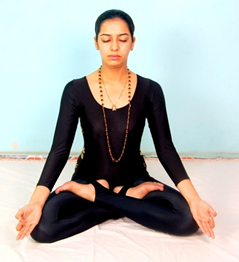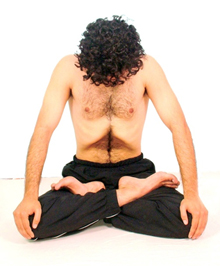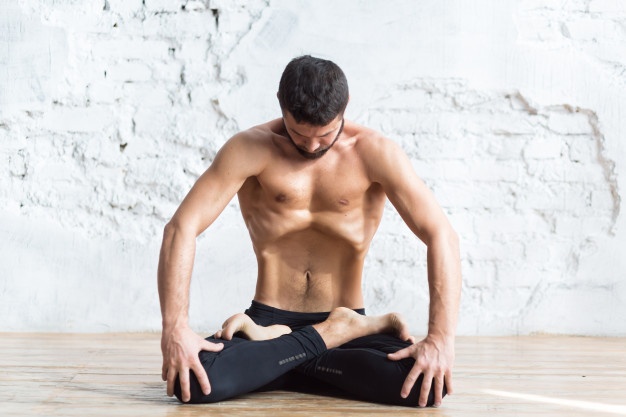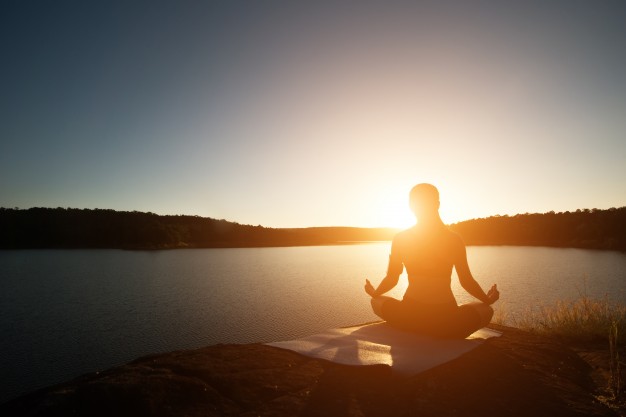The Sanskrit word Bandha means to ‘hold’ or to ‘lock’. Bandha aims to lock the Prana in particular areas and redirect their flow into Sushumna Nadi for the purpose of spiritual awakening.
Bandhas are the locks to restrict or apply Pranic power in a particular area as we develop dams to check the free flow and wastage of water and apply it to generate energy.
When to practice Bandha?
Bandhas may be practiced individually or can be incorporated with Asanas or pranayam and even mudras.
Types of Bandha
- Mool Bandha
- Uddiyan Bandha
- Jalandhar Bandha
- Maha Bandha
Mool Bandha:

Mool Bandha is also known as perineum contraction. It provides many physical, mental and spiritual benefits, stimulates the pelvis nerves and tones the uro-genital and excretory systems. It also relieves constipation and piles and is beneficial in case of anal fissures, ulcers, prostatitis, prostatic hypertrophy and chronic pelvic infections. It’s highly beneficial in case of asthama, bronchitis and arthritis, relieves depression and leads the practitioner towards spiritual awakening. It also helps to attain sexual control and to alleviate a multitude of sexual disorders.
Preparation:
- Sit in Siddhaasana / Siddha Yoni Asana/ or Padmaasana position.
- Concentrate on natural flow of breath with relaxed body and closed eyes.
- Focus on awareness on perineal / vaginal region.
Procedure:
- Slowly contract perineal / vaginal region by pulling up on the muscles on the pelvic floor and hold the contraction without holding breath (with normal breathing).
- Contract only muscles related to the mooladhar region keeping rest of the body relaxed.
- In the beginning anal and urinary sphincters also contract but as the practice deepens it will be minimized and will eventually cease.
Precaution:
- It must only be performed under the expert guidance of a guru / master.
- It raises the energies very fast and can precipitate symptoms of hyper activity if wrongly practiced.
Uddiyan Bandha:

Uddiyan Bandha is associated with Manipur Chakra that sustains the Annmaya Kosha, the physical body and governs digestion and metabolism.
It is a sure cure to constipation, indigestion, worms and diabetes if they are not chronic, chronic patients will do it with certain other combinations. Uddiyan Bandha improves the digestive fire and balances the adrenal glands. Even tension and anxiety get cured and whole trunk area gets better blood circulation. It is a preventive Kriya for ulcer, hernia and asthma. The best benefit of Uddiyan Bandha is the stimulation of Manipur Chakra that gives proper distribution of energy to entire body.
Preparation:
- Sit in Padmaasana resting right leg on left thigh and left leg on right thigh with soles facing sky.
- Try to touch both knees to floor and keep the thighs, knees and pelvis relaxed.
- Maintain the spine, neck and head in one straight but still tense-free line.
- Obtain Gyan Mudra by folding the index fingers to touch the inside root of thumbs and keep the other three fingers straight, relaxed and slightly apart and place the wrists on knees with palms facing upward.
- Beginners who fail to attain this posture may sit in half lotus or Ardha Padmaasana and practice with changed position of feet every day.
- Close the eyes to relax your mind and body.
Procedure:
- Breathe deep through nose only and exhale deep emptying the lungs as much as possible holding the breath outside and contracting the stomach seep at navel.
- Press down your wrists on the knees and contract the abdominal muscles inward and upward.
- Maintain this abdominal lock and hold the breath out position for as long as you can without putting any extra strain on your lungs.
- Now relax your wrists and release the Uddiyan Bandha and allow a slow and deep inhalation.
- Relax until your breathing is normalized, then begin the next round.
- You may begin with practice of three to five rounds and gradually increase to ten rounds within a couple of months.
- Remember that Uddiyan Bandha is performed with external breath retention only.
Precautions:
In case of ulcer, high blood pressure and heart disease Uddiyan Bandha is not recommended. Patients suffering from asthma and hernia are advised to practice Uddiyan Bandha under expert guidance only.
Jalandhar Bandha:

Jalandhar Bandha regulates the circulatory and respiratory systems, stimulates the thyroid to balance metabolism, and is said to cure all diseases of the throat.
Preparation:
- Sit in Padmaasana or a comfortable Siddhaasana or Sukhaasana cross-legged seated position with the palms facing down on top of the knees.
- Let the spine be long, the shoulders relaxed down and the sternum lifted.
- Let the eyes softly close and the breath slow down and deepen.
Procedure:
- Take a slow deep inhale to two thirds of your lung’s capacity and hold the breath in.
- Drop the chin to the chest and draw it in so the back of the neck stays long and does not round.
- Let the shoulders roll very slightly forward to deepen the lock in the throat, but keep them soft.
- Hold the chin lock for as long as comfortable, without strain.
- To release, bring the chin up first and very slowly leave the breath out through the nose.
- Take a few slow deep breaths in and out and allow your breath return to normal before practicing additional rounds.
- Begin with practicing three rounds and you can slowly increase it to up to ten rounds over time.
Precaution:
The Bandha is not to be practiced by persons suffering from breath related problems or high or low blood pressure, unless advised by the experts in the field.
Maha Bandha: (Tri bandha):

Maha Bandha or the Great Lock combines all the three main Bandhas or locks –Moola Bandha, Uddiyan Bandha and Jalandhar Bandha.
Maha in Sanskrit means ‘great’ or ‘supreme’ and the word Bandha means a lock. Maha Bandha means the great lock. Maha Bandha is said to activate the Pranashakti thereby aiding the awakening of Kundalini Shakti at the base of the spine. Maha Bandha is also called the tri-bandha or the triple lock as it involves all the three major locks.
Please note that the practice of Maha Bandha is described differently in Hatha Yog Pradeepika and the Gheranda Samhita. The description in this article is based on how it is practiced in the modern day using the three basic locks
The practice of Maha Bandha must be taken up only after one masters the three locks – Moola Bandha (Root Lock), Uddiyan Bandha (The Abdominal Lock) and Jalandhar Bandha (The Chin Lock), separately. First practice all the three Bandhas separately, and then integrate all of them together to do Maha Bandha.
Maha Bandha is a good practice to prepare you for higher practices of meditation and Samadhi.
Benefits of Maha Bandha –
- Maha Bandha gives the combined benefits of all the three basic bandhas – Moola Bandha, Uddiyan Bandha and Jalandhar Bandha.
- It also activates the three chakras – Mooladhar Chakra, Manipuraka Chakra and Vishuddhi Chakra.
- It activates the pineal glands and therefore regulates the entire endocrinal glands.
- It rejuvenates the cells in the entire body and hence helps as an anti-aging mechanism.
- During initial stages there is discomfort to retain the breath. But with practice, breath can be retained for longer durations. When the lock is released, there is a general sense of well-being and bliss. The mind calms down and there is experience of a peaceful state. It removes the afflictions of the mind like anger and lust.
- Maha Bandha is practiced by yogis to attain a peaceful and introverted state of mind before starting the practice of meditation.
- The practice of Maha Bandha, pulls the Pranic energy upwards. The Apanavayu is pulled up and merges with the Pranavayu in the abdominal region, which is the seat of Samanavayu. This awakens the Pranashakti which brings about heightened levels of awareness. With practice it will help in the awakening of the Kundalini Shakti resting at the base of the spine as well.
- Maha Bandha is described as the conqueror of old age and death. Also, all the desires of the yogi are fulfilled by practicing this Bandha.
Preparation:
- Sit in a comfortable meditative posture, preferably Padmaasana or Siddhaasana. If you have difficulty sitting in these Asanas, then sit in any easy cross-legged pose like half Lotus Pose (Ardha Padmaasana) or Sukhaasana.
- Keep the spine erect. Breathe normally and relax the whole body.
- Keep the palms on the knees and close your eyes.
Procedure:
- Take a deep breath and then exhale fully. Simultaneously perform Moola Bandha (The root lock), then Uddiyan Bandha (The abdominal lock) and then the Jalandhar Bandha (The chin lock) in that order. Retain the breath outside.
- Retain the breath outside for as long as you are comfortable.
- To release the Maha Bandha, first release Jalandhar Bandha (chin lock), then the Uddiyan Bandha (abdominal lock) and then finally the Moola Bandha (root lock) in that order.
- This is one round of Maha Bandha.
Precaution:
Maha Bandha should not be practiced by those suffering from blood pressure problems, heart diseases, asthma, ulcer of stomach or intestine, stroke and paralysis. Also pregnant women should avoid this practice. Maha Bandha should be practiced under the guidance of an experienced yoga instructor after you have mastered the three basic locks.
Maha Bandha is an advanced practice and should be learnt under the guidance of an expert. There should not be any strain while holding the breath outside. If there is any discomfort, release the lock and breathe normally.

Acharya Pratishtha is an internationally acclaimed yoga guru, director of Mokshayatan Yog Sansthan and a member of key yoga committees of the Government of India. She is the author of five books, creator of CDs & DVDs and a presenter of television shows on yoga.







